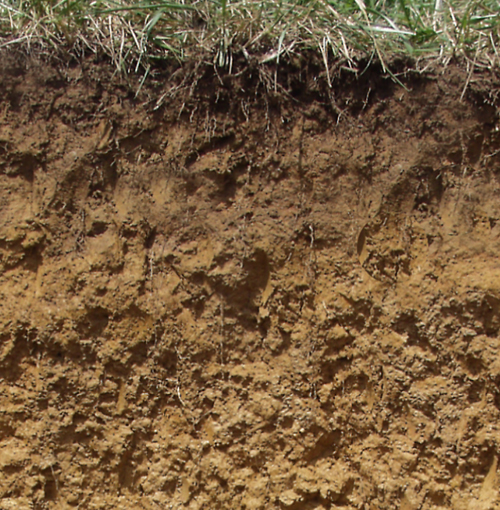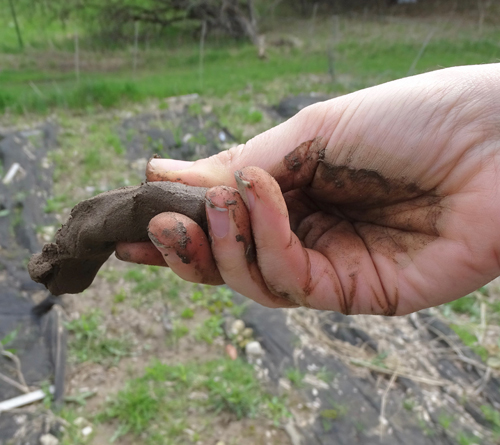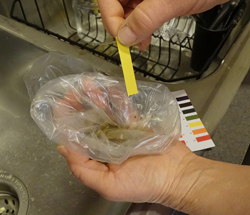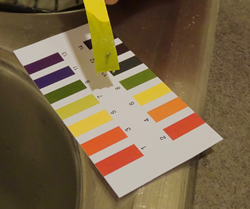If you are outside and want to know something about the soil you are working with, and don’t have any fancy equipment, then this is for you. With a little bit of experience you can get an idea of how much organic matter you have in your soil, how much clay you have, and how acidic or basic your soil is. The equipment you need is: 1) your eyes; 2) your hands; 3) a little water; and 4) a piece of pH litmus paper (never leave home without it).

Organic matter –Organic matter is a source of plant nutrients, the source of energy for soil organisms, and a sponge for holding water in the soil. To know something about soil organic matter, just look at the color of the soil. You can’t be quantitative when estimating organic matter in the field if all you have is the color, but you can tell if you have a lot or a little. Organic matter makes the soil dark brown to black; the darker the soil, the more organic matter. For example, if your soil is reddish or light brown, it doesn’t have much organic matter. If your soil is dark black then it has an abundant amount.
Put a shovel in the ground and dig a hole to about 1 foot or more (after calling Digger’s Hotline!). At the surface of the soil, you will see the darkest colors. This is typically where the greatest amount of organic matter is found. As you go deeper, the color becomes lighter, meaning that the amount of organic matter is decreasing. Dig until the background color becomes as light as it seems to get. Since the dark color comes from organic matter, compare the color in the surface to the natural soil color you’ve found. In most cases a depth of about a foot will show you the base color – and you can compare your upper layer colors from there. It would be nice to have around 6 inches or more of dark color. If you do not have a dark color, you’ll want to add compost or peat to your soil before planting.

Clay – You probably did this as a child. What we want to measure is called soil texture. Another way of saying this is how much sand, silt and clay is in my soil? For your garden, you want a good distribution of sand, silt and clay. Each brings desirable properties to the soil. The sand helps the water drain through the soil. Clay (along with organic matter) is the “bioreactor” of the soil, as it holds water and nutrients. Silt is very fine particulate matter (think baby powder/talcum powder). The field method for estimating soil clay is based on the fact that clay gives the soil a sticky, cohesive property, while sand does not. You will need to add water to about 3 tablespoons of soil in your hand until the soil can be ‘molded’. Move the mixture in your palm to see if it will form a ball. If it does not, your soil is sandy. Depending on the amount of organic matter in the soil, it will not hold sufficient water for your garden. Adding organic matter will help (see above about organic matter). If it does form a ball, see how far you can make a soil “ribbon” by squeezing it between your thumb and forefinger. The more clay you have in your soil, the longer will be the ribbon you can form. A soil with the best physical properties for your garden will form a ribbon 1 to 2 inches long. The more sand you have (the shorter the ribbon) the more organic matter you may want to add. To follow more detailed instructions for determining soil texture – like soil scientists do in the field, visit https://www.nrcs.usda.gov/wps/portal/nrcs/detail/soils/edu/?cid=nrcs142p2_054311.

Soil pH – Soil pH tells you how acidic or basic your soil is. The pH scale is a chemical term. A pH of 7 is neutral, below 7 is acidic, and above 7 is basic. Soils can range from a pH of about 4.0 to 8.6 or higher. Most plants prefer a pH in the range of 5.5 to 6.5, or a bit on the acidic side. Soil pH is important because it determines the environment for soil organisms and the availability of plant nutrients. All plants don’t want the same pH. Some like a very acid soil (blueberries for example) but some don’t. You measure pH in the field with pH litmus paper (purchase at any major retail store). Put some soil in a 6 ounce cup or baggie. Add distilled water until the soil is a paste. Let it sit for 5 minutes or so. Tilt the cup or baggie to the side, allowing some water to drain to the side. Dip in a piece of litmus paper. Compare the color on the paper with the chart provided with your litmus paper to determine your pH.

These simple at-home tests give you valuable knowledge about your garden soil. Most homes don’t have “perfect” soil, and soil conditions can change from year to year. Doing these tests before your gardening season, and amending your soil accordingly, can bring you healthier produce, lawns and yard plants.
Answered by Nick Comerford, University of Florida
To receive notices about future blogs, be sure to subscribe to Soils Matter by clicking on the Follow button on the upper right! Explore more on our webpage About Soils. There you will find more information about Soil Basics, Community Gardens, Green Infrastructure, Green Roofs, Soil Contaminants, materials for Teachers and more.
For another activity on soil texturing, visit http://www.soils4teachers.org/files/s4t/texture.pdf

Nice sir
Reblogged this on Lacey D Russell.
Thanks for the reblog!
Reblogged this on Blog by Mr-Bill.
Reblogged on https://winmrbill.wordpress.com/
Thanks for the reblog, and thanks for being a reader! Good luck with your garden this year. SF
Reblogged this on BlogSoilsLincoln and commented:
Get your hands dirty!
Thanks for the reblog! SF